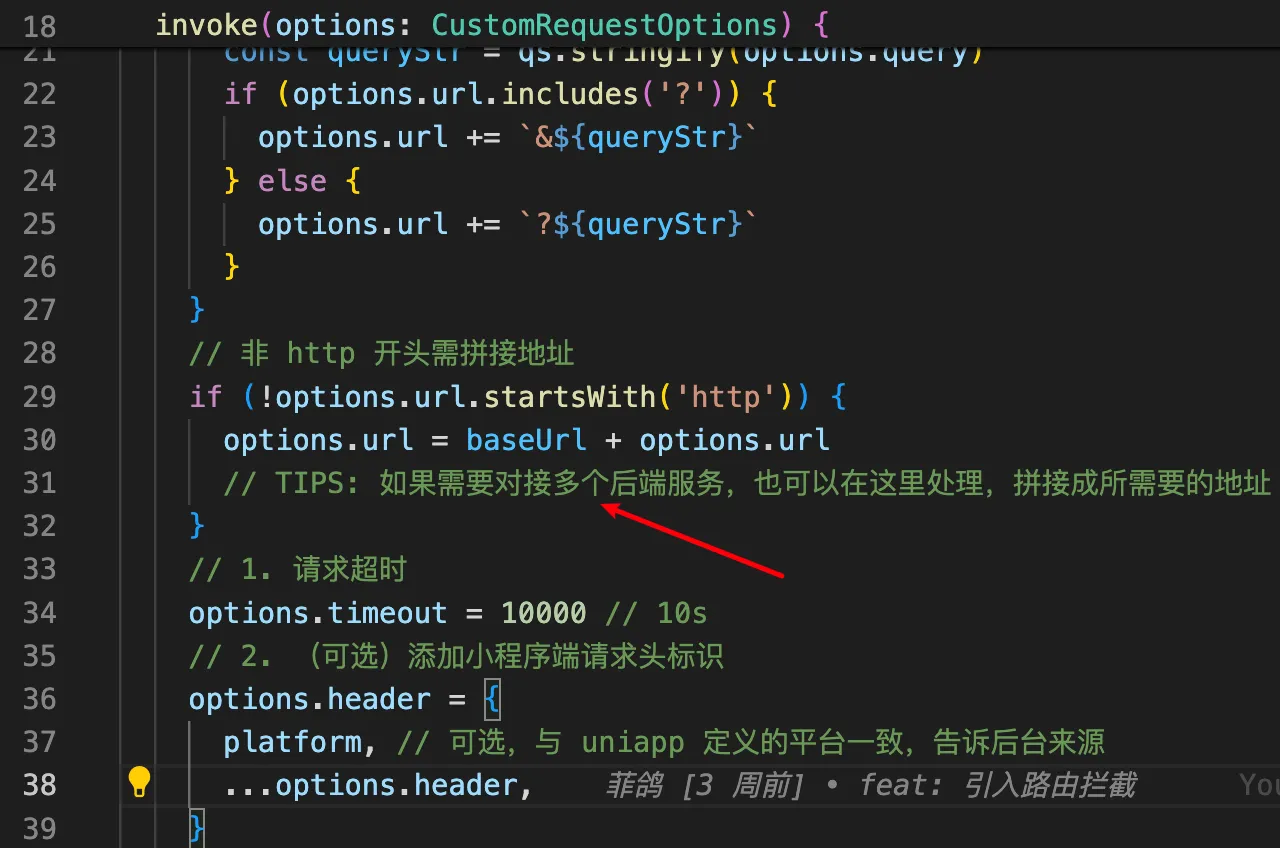请求篇
本篇分为三块内容:
- 普通请求
- 图片上传
- 多后台地址
普通请求
普通请求分 2 种处理,一种是只在页面请求一次的一次性请求,这种请求占大多数;一种是项目多处用到的请求,这种请求占小部分,需要单独编写一个请求函数放到 api文件夹 or service文件夹。
unibest里面是使用service文件夹后面不再说明。
下面来分别演示:
一次性请求
template 部分编码如下:
html
<template>
<button @click="run">请求</button>
<view v-if="loading" class="text-blue h-10">请求中...</view>
<view v-if="error" class="text-red h-10">请求错误</view>
<view v-else class="text-green h-10">{{ JSON.stringify(data) }}</view>
</template>script 部分使用 菲鸽 封装好的 useRequest 即可实现请求状态一体化,如下:
ts
<script setup>
type IFooItem = { name: string }
const { loading, error, data, run } = useRequest<IFooItem>(() => httpGet('/foo', { name: '菲鸽' }))
</script>看吧,使用非常简单。
重复性请求
重复性请求 与 一次性请求 的 html部分 是一样的,唯一的区别是 请求函数 放到了 service文件夹,如下所示:
ts
<script setup>
import { getFooAPI, IFooItem } from '@/service/index/foo' // 看这里
const { loading, error, data, run } = useRequest<IFooItem>(() => getFooAPI('菲鸽'))
</script>对应的 src/service/index/foo.ts 文件如下:
ts
import { http, httpGet } from '@/utils/http'
export interface IFooItem {
id: string
name: string
}
/** GET 请求 */
export const getFooAPI = (name: string) => {
return http<IFooItem>({
url: `/foo`,
method: 'GET',
query: { name },
})
}
/** GET 请求 - 再次简化,看大家是否喜欢这种简化 */
export const getFooAPI2 = (name: string) => {
return httpGet<IFooItem>('/foo', { name })
}依然非常简洁,深受妹子喜爱。
图片上传
template 部分编码如下:
html
<template>
<view class="p-4 text-center">
<wd-button @click="run">选择图片并上传</wd-button>
<view v-if="loading" class="text-blue h-10">上传...</view>
<template v-else>
<view class="m-2">上传后返回的图片地址:</view>
<view class="m-2">{{ data }}</view>
<view class="h-80 w-full">
<image v-if="data" :src="data" mode="scaleToFill" />
</view>
</template>
</view>
</template>script 部分使用 菲鸽 封装好的 useUpload 即可实现请求状态一体化,如下:
ts
<script lang="ts" setup>
const { loading, data, run } = useUpload<string>({ user: '菲鸽' })
</script>使用非常简单,深受汉子和妹子的喜爱。
多后台地址
上面的 普通请求 默认是只有一个请求地址的,在 .env 里面配置 VITE_SERVER_BASEURL,如下:
text
VITE_SERVER_BASEURL = 'https://ukw0y1.laf.run'并且在 src/interceptors/request.ts 里面有设置:
- 如果是
http开头的请求路径,则直接请求 - 如果不是,则拼接上
VITE_SERVER_BASEURL

但在多后台地址时就不能这么玩了,需要处理如下:(关注上图的箭头部分)
ts
// 可以写一个映射对象,如:
const proxyMap = {
cms:'http://localhost:8080/cms',
ums:'http://localhost:8080/ums',
}
// 拦截器部分(上图箭头部分)修改如下
Object.keys(proxyMap).forEach(key=>{
if(options.url.startsWith(`/${key}`)){
options.url = proxyMap[key] + options.url
}
}
// 接口调用的地方使用如下格式:
export const getFooAPI = (name: string) => {
return http<IFooItem>({
url: `/cms/foo`, // 看这里,前缀不用!!!
method: 'GET',
query: { name },
})
}环境变量配置
普通请求需要在.env里面配置VITE_SERVER_BASEURL,用在src/interceptors/request.ts文件拼接请求地址;而多后台地址时则用不上,可以删除。
text
VITE_SERVER_BASEURL = 'https://ukw0y1.laf.run'图片上传需要在.env里面配置VITE_UPLOAD_BASEURL:
text
VITE_UPLOAD_BASEURL = 'https://ukw0y1.laf.run/upload'全文完~